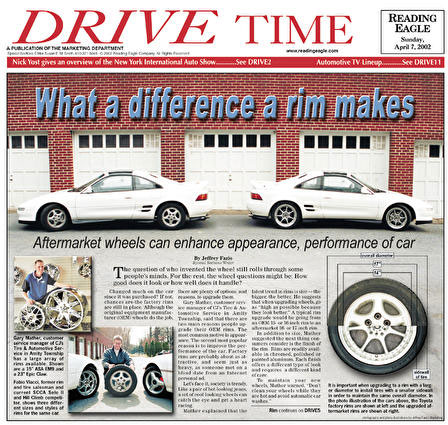
What a difference a
rim makes
Aftermarket wheels can
enhance performance, appearance of car
By
Jeffrey Fazio
Special Sections Writer
The question of who invented the wheel still rolls through some peopleís minds. For the rest, the wheel questions might be: How good does it look or how well does it handle?
Changed much on the car since it was purchased? If not, chances are the factory rims are still in place. Although the original equipment manufacturer (OEM) wheels do the job, there are plenty of options, and reasons, to upgrade them.
Gary Mather, customer service manager of CJís Tire & Automotive Service in Amity Township, said that there are two main reasons people upgrade their OEM rims. The most common motive is appearance. The second most popular reason is to improve the performance of the car. Factory rims are probably about as attractive, and seem just as heavy, as someone met on a blind date from an Internet personal ad.
Letís face it, society is trendy. Like a pair of hot-looking jeans, a set of cool-looking wheels can catch the eye and get a heart racing.
Mather explained that the latest trend in rims is size ó the bigger, the better. He suggests that when upgrading wheels, go as "high as possible because they look better." A typical rim upgrade would be going from an OEM 15- or 16-inch rim to an aftermarket 16- or 17-inch rim.
In addition to size, Mather suggested the next thing consumers consider is the finish of the rim. Rims are readily available in chromed, polished or painted aluminum. Each finish offers a different type of look and requires a different kind of care.
To maintain your new wheels, Mather warned, "Donít clean your wheels while they are hot and avoid automatic car washes."
He said some car washes even have warning signs about potential damage to the finish of aftermarket wheels. He added that cleaning wheels while they are hot could mark their surface.
If the goal is to improve the performance of the wheels, Fabio Vlacci, former rim and tire salesman and current SCCA Solo II and Hill Climb competitor, advised upgrading to a wider, lightweight rim and, depending on your comfort level, a taller rim.
Vlacci of Mohnton explained that a wider rim will allow installation of wider tires. This gives the car a larger "foot print," which translates to more grip. When using a wider wheel, Vlacci pointed out to be careful of the offset of the new rim.
The rimís offset is the distance from the hubís mounting surface to the centerline of the wheel.
"Using the wrong offset puts undue pressure on the hub bearing," said Vlacci. "The wrong offset could cause the rim to rub the brake caliper or stick out past the fenders, which is illegal in Pennsylvania."
A lighter rim reduces the unsprung weight of the car, which increases handling, Vlacci explained. Since weight is a basic factor in most physics equations, reducing it affects all aspects of a wheelís performance. It is easier to accelerate and, more important, to stop a lighter wheel than a heavier one.
When considering a larger diameter wheel, Vlacci pointed out several things to consider. A larger diameter rim means lower-profile tires should be installed to maintain the same overall diameter. Lower-profile tires have smaller sidewalls which makes the tire stiffer. The rigidity attributed to lower-profile tires translates into less flex of tire which means better handling. The downside of low-profile tires is ride comfort.
"The sidewall of your tires is the first point of your suspension," said Vlacci. "So a stiffer sidewall will allow you to feel more bumps in the road."
Another point Vlacci said to consider is how a larger rim and tire combination can affect your speedometer. As long as the same overall outside diameter of the tire is maintained as the car had from the factory, there will not be a problem. However, when deviating from that diameter, it starts affecting the accuracy of the speedometer.
A taller tire and rim combination will travel further with each revolution of the axle, thus throwing off the accuracy of the speedometer. In contrast, a smaller tire and rim combination will travel less distance, also resulting in an incorrect speedometer reading.
Mather points out that the other big risk of larger rims is damage. With a large rim if you "hit something hard enough, you are going to bend them," Mather explained. Since low-profile tires are less flexible, more of the energy of a big bump is transferred to the rim.
Taking all of this into consideration, Vlacci upgraded the factory rims on his own car. He changed his factory 14-inch rims to a wider aftermarket 15-inch wheel. Although Vlacci agreed that a 16- or 17-inch rim would look better, he didnít feel it was worth the risk of damage on local roadways. A better-looking rim designed for improved handling is what he bought.
So whether trying to catch an apex of a curve or someone elseís eye, upgrading wheels can be an effective tool.